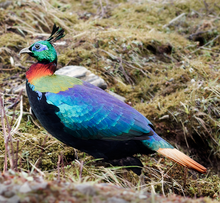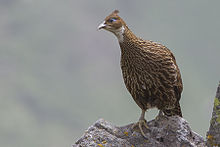Himalayan monal
| Himalayan monal | |
|---|---|

| |
| Male | |

| |
| Female | |
| Scientific classification | |
| Domain: | Eukaryota |
| Kingdom: | Animalia |
| Phylum: | Chordata |
| Class: | Aves |
| Order: | Galliformes |
| Family: | Phasianidae |
| Genus: | Lophophorus |
| Species: | L. impejanus
|
| Binomial name | |
| Lophophorus impejanus (Latham,1790)
| |
TheHimalayan monal(Lophophorus impejanus), also calledImpeyan monalandImpeyan pheasant,is apheasantnative toHimalayanforests and shrublands at elevations of 2,100–4,500 m (6,900–14,800 ft). It is part of the familyPhasianidaeand is listed asLeast Concernon theIUCN Red List.[1] It is thenational birdofNepal,where it is known as thedanpheordanfe,[2]andstate birdofUttarakhand,India, where it is known as amonal.[3] The scientific name commemorates LadyMary Impey,the wife of the British chief justice ofBengal,SirElijah Impey.
Description
[edit]It is a relatively large-sized pheasant. The bird is about 70 cm (28 in) long. The male weighs up to 2,380 g (84 oz) and the female 2,150 g (76 oz). The adult male has multicolouredplumagethroughout, while the female, as in other pheasants, is more subdued in colour. Notable features in the male include a long, metallic green crest, coppery feathers on the back and neck, and a prominent white rump that is most visible when the bird is in flight. The tail feathers of the male are uniformly rufous, becoming darker towards the tips, whereas the lower tail coverts of females are white, barred with black and red. The female has a prominent white patch on the throat and a white strip on the tail. The first-year male and the juvenile resemble the female, but the first-year male is larger and the juvenile is less distinctly marked.
Distribution and habitat
[edit]
The Himalayan monal's native range extends fromAfghanistanandPakistanthrough theHimalayasinIndia,Nepal,southernTibetandBhutan.[1] In Pakistan, it is most common in theKhyber Pakhtunkhwaprovince and has also been recorded inKaghan,Palas ValleyandAzad Kashmir.[4]In India, it has been recorded throughout theIndian Himalayan RegionfromJammu and KashmirtoArunachal Pradesh.[5] It lives in upper temperateoak-coniferforests interspersed with open grassy slopes, cliffs and alpine meadows between 2,400 and 4,500 m (7,900 and 14,800 ft), where it is most common between 2,700 and 3,700 m (8,900 and 12,100 ft). It descends to 2,000 m (6,600 ft) in the winter. It tolerates snow and digs through it to obtain plant roots and invertebrate prey.[citation needed]
Behaviour and ecology
[edit]
The diet of the Himalayan monal consists primarily of tubers, nuts, tender leaves, shoots, insects and other invertebrates. It digs in snow for shoots and invertebrates. Plant matter made up a large part of the diet, although invertebrate matter was also present in low percentages.[6]
Conservation
[edit]In some areas, the Himalayan monal is threatened due topoachingand other anthropogenic factors. In the western Himalayas, the population responded negatively to human disturbance involvinghydroelectric powerdevelopment.[7]It is not considered endangered in Pakistan and can be easily located. In some areas, the population density of the species is as high as five pairs per square mile. The main threat to the species is poaching, as the crest is valuable. It is thought to bring status to its wearer and is a symbol of authority.[4]
References
[edit]- ^abcdBirdLife International (2016)."Lophophorus impejanus".IUCN Red List of Threatened Species.2016:e.T22679182A92806166.doi:10.2305/IUCN.UK.2016-3.RLTS.T22679182A92806166.en.Retrieved19 January2022.
- ^"Animal stories: Danfe".The Himalayan Times.2007.Retrieved2019-12-03.
- ^Goswami, A. (2012)."सबसे सुंदर पंछियों में से एक मोनाल"[Monal is one of the most beautiful birds].Prabha Sakshi(in Hindi). Archived fromthe originalon 12 April 2013.
- ^ab"Himalayan Monal".Pheasants of Pakistan.Wildlife of Pakistan.Retrieved24 February2013.
- ^"Sclater's Monal and Himalayan Monal sighted in Arunachal's Upper Siang".EastMojo. 2021-06-08.
- ^Hussain, M.S.; Sultana, A. (2013)."Diet of threatened Pheasant species in Himalayas, India – A faecal analysis approach".Ecologia Balkanica.5(1): 57–68.
- ^Jolli, V. & Pandit, M. K. (2011). "Influence of human disturbance on the abundance of Himalayan Pheasant (Aves, Galliformes) in the temperate forest of Western Himalaya, India".Vestnik Zoologii.45(6): e40–e47.doi:10.2478/v10058-011-0035-0.S2CID55089271.

